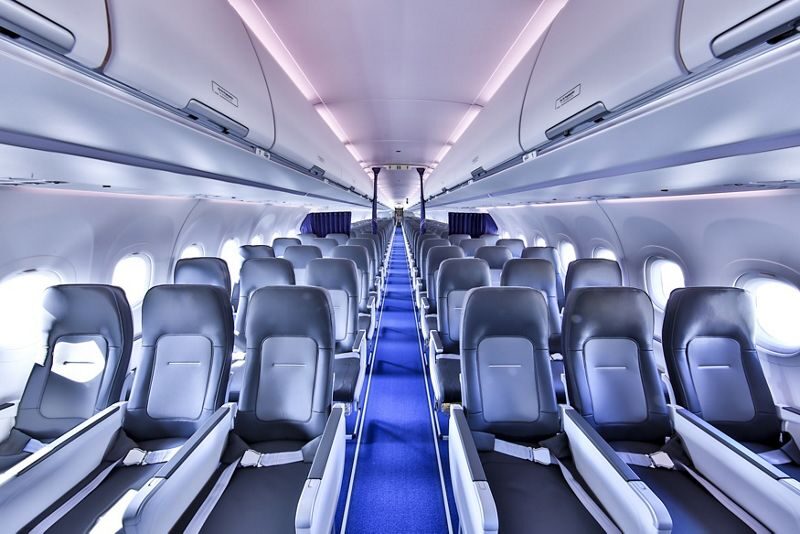Aviation
Airbus’ new Single-Aisle Airspace cabin enters into service with Lufthansa Group

First airline in Europe to feature Airbus’ new Airspace cabin on Single-Aisle aircraft
Frankfurt, 6. September 2021 – Lufthansa has started operations with its first A320 Family aircraft – an A321neo – featuring Airbus’ new Single-Aisle Airspace cabin. In doing so, the airline becomes the first operator in Europe to introduce the new Airspace cabin features for passengers on board A320 Family aircraft. In 2018 Lufthansa Group, a long-time A320 Family customer, chose to equip more than 80 of its new A320 Family aircraft on order from Airbus with Airspace cabins.
The new Airspace features include: slimmer sidewall panels for extra personal space at shoulder level; better views through the windows with their redesigned bezels and completely integrated window shades; the largest overhead bins for 60% more bags; the latest full LED lighting technologies; LED-lit ‘entrance area’; and new lavatories with hygienic touchless features and antimicrobial surfaces.
“Lufthansa has once again made a choice of innovation and passenger appeal, raising the bar for the flying public at large to experience next-level, Airbus leading cabin innovations”, said Christian Scherer, Airbus Chief Commercial Officer and Head of International. “I am delighted to welcome one of our long term partners, Lufthansa, to become the first European operator for the A320neo Family Airspace cabin. I can’t wait to fly on one of these aircraft.”
“Regardless of the crisis, we continue to focus emphatically on a premium product for our guests,” emphasizes Heike Birlenbach, Head of Customer Experience, Lufthansa Group. “For us, premium means providing high-quality, individualized and relevant offers for all our passengers at all times. With the new Airspace Cabin, we are significantly improving the travel experience on short-haul routes and setting a new industry benchmark.”
10 Things to know About IndiGo Airline, India 2021
Lufthansa has been operating the A320-family since the 1980s and has been the very first operator of the A321 and the A320neo. The airline group is one of the biggest Airbus operators worldwide.
At the end of July 2021, the A320neo Family had received more than 7,400 orders from over 120 customers worldwide.
Lufthansa turning Airbus A350-900 into a Flying Research Lab
#Airbus #Lufthansa #A321neo #Airspace

Aviation
Airbus Enhances A350 Cabin with 10-Abreast Seating

Airbus has announced a new partnership with Jiatai Aircraft Equipment, a Chinese aircraft seating manufacturer, to supply upgraded economy-class seats for the A350 widebody series.
This collaboration, unveiled at the 2024 Airshow China, focuses on developing a newly designed economy seat tailored for the A350‘s New Production Standard (NPS) cabin.
One of the key features of the NPS cabin is the ability to accommodate 17-inch wide economy seats, compared to the previous 16.5-inch wide seats that airlines were limited to in the A350’s earlier configurations.
British Airways Unveils Its Brand-New First Class Cabin for the Airbus A380
This change is made possible by the expanded space in the NPS cabin, which is 35 inches longer and 4 inches wider than the previous version. This extra space is achieved by slightly moving the cockpit wall forward and shifting the rear pressure bulkhead back by one frame.
The wider cabin allows airlines to add up to 30 extra economy seats without compromising comfort. For airlines opting for a 3-4-3 seating layout, the 17-inch wide seats are an excellent choice for a more comfortable passenger experience. However, some airlines, such as Iberia, may choose to retain a 9-abreast layout with wider seats for added comfort.
The NPS cabin also offers enhanced flexibility for airline operators. One major advantage is the ability to easily switch between a 9-abreast and 10-abreast seating configuration without requiring significant downtime for aircraft reconfiguration. Airlines can use the same seat rails, tracks, and IFE interfaces, making the transition smoother and quicker.
Etihad Airways Unveils 10 Exciting New Routes for 2025
In addition, the design of the floor attachments and air-conditioning systems has been optimized for 10-abreast seating, meaning airlines can upgrade their cabins without needing to make substantial modifications to the aircraft’s structure.
Though it’s still unclear when Jiatai’s economy-class seats will be officially added to the A350’s Buyer Furnished Equipment (BFE) catalogue, the collaboration marks a significant step toward enhancing the A350’s cabin offerings.
With this partnership, Airbus is providing more seating options for airlines, ensuring that they can meet diverse customer needs while improving overall operational efficiency.
-

 Aviation2 months ago
Aviation2 months agoMicrosoft Flight Simulator Raises $3 Million to Bring Back the An-225 Mriya
-

 Airlines2 months ago
Airlines2 months agoQatar Citizens Can Travel to the United States Without a Visa
-

 Aviation2 months ago
Aviation2 months agoQatar Airways bans these new Electronic Devices on plane
-

 Airlines2 months ago
Airlines2 months agoJapan Airlines Rolls Out Free Domestic Flights to International Passengers
-

 Travel2 months ago
Travel2 months agoQatar Airways Launches Four Additional Flights from Amsterdam
-

 Defence2 months ago
Defence2 months agoWhich Country Has the Largest Fleet of Fighter Aircraft?
-

 Airport2 months ago
Airport2 months agoWestern Sydney Airport Welcomes Its First Plane After 6 Years of construction
-

 Airlines4 days ago
Airlines4 days agoDAMAC Air: Dubai’s New Luxury Airline Offers Free Flights for Registration








